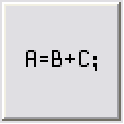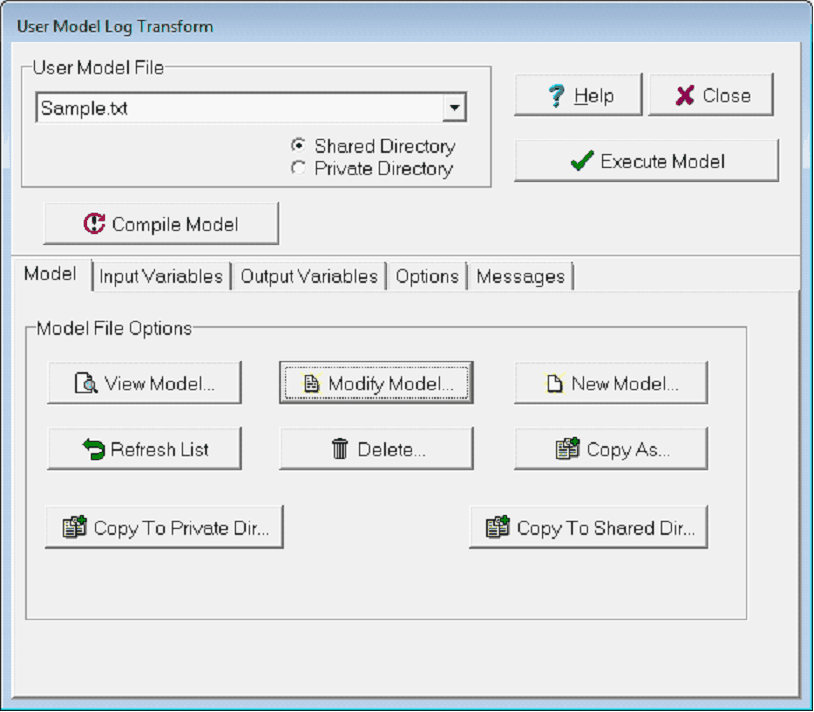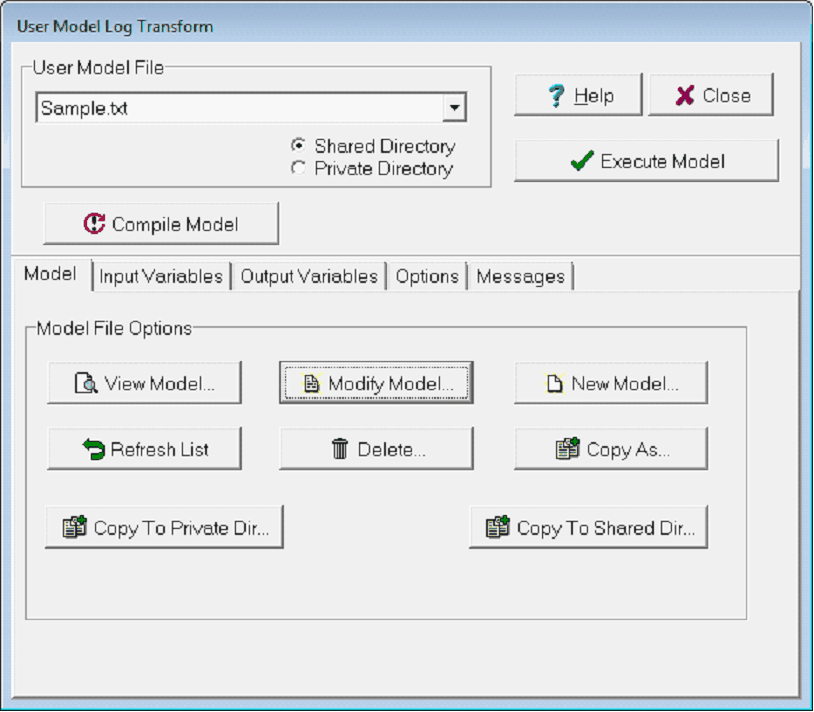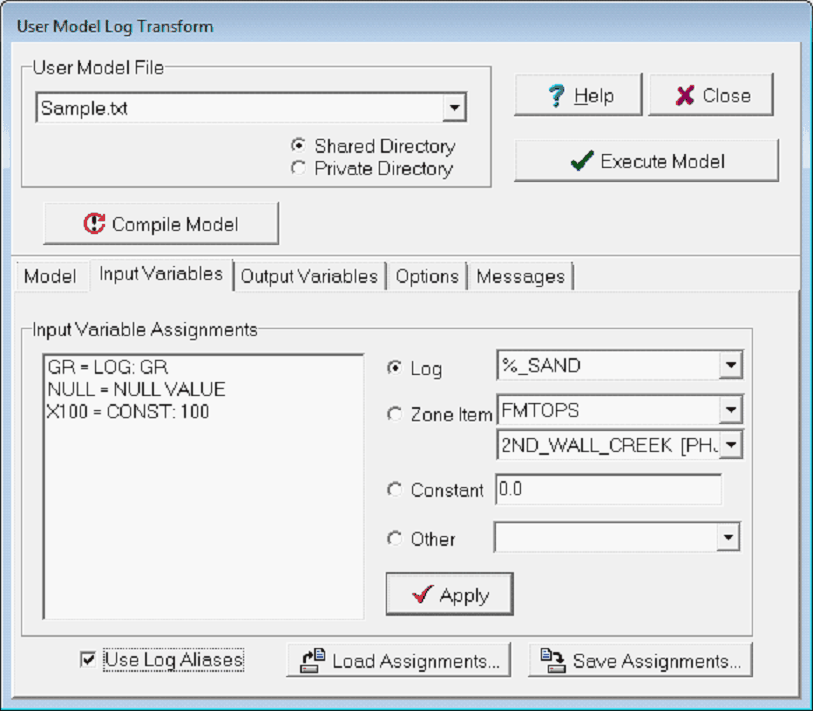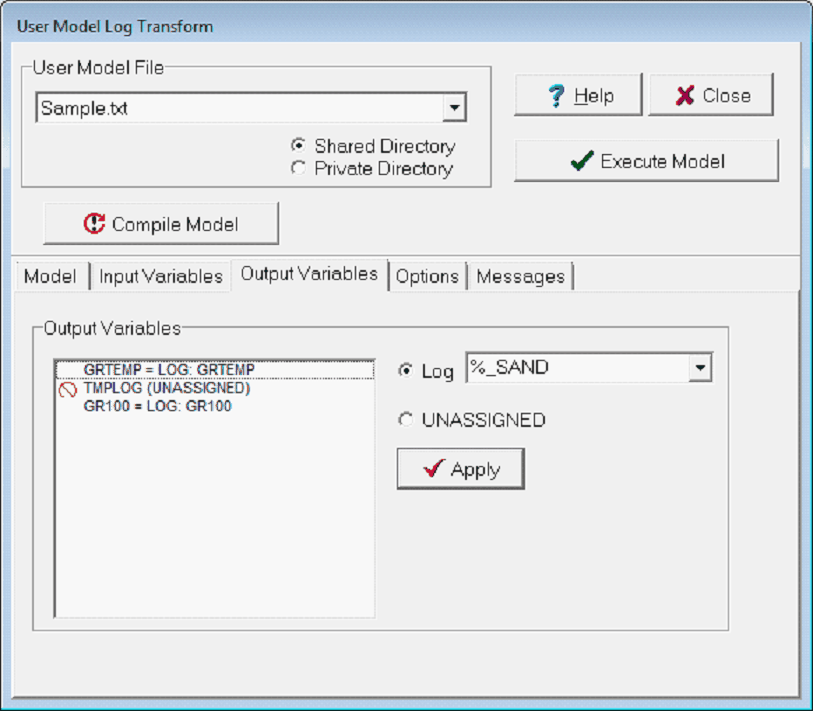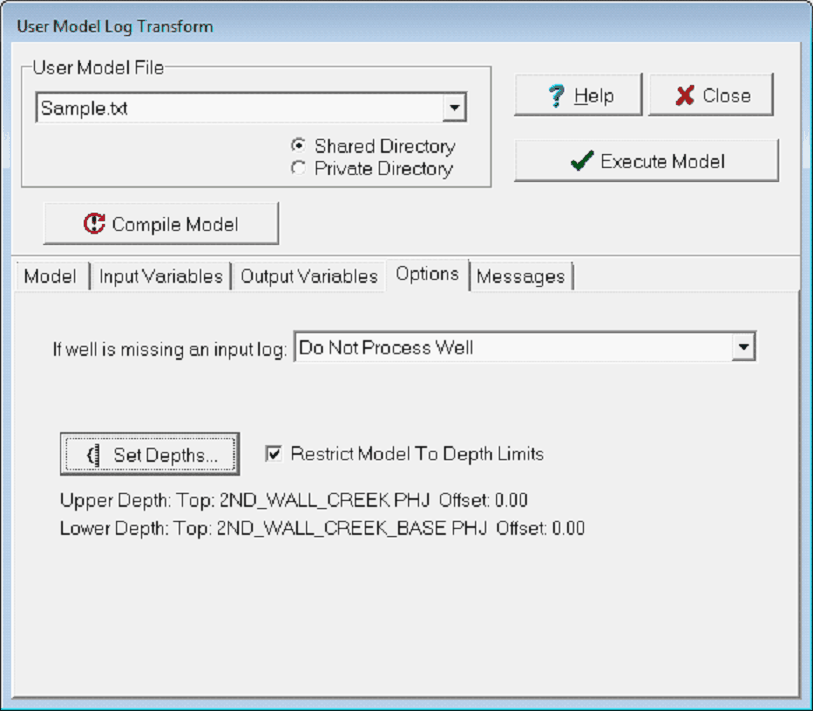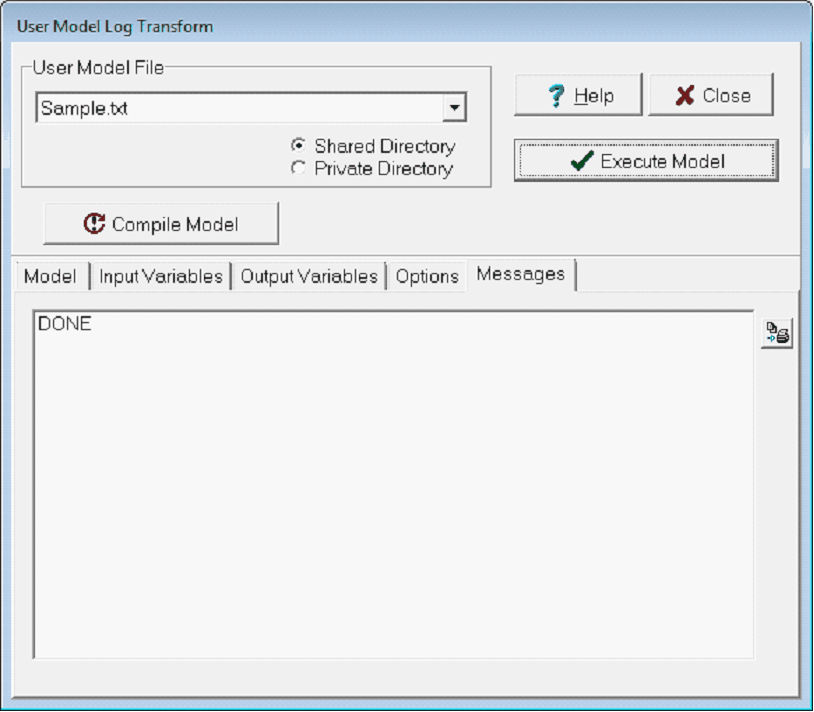User Model - Log Transform |
|
User models can perform log analysis functions such as computing clay volume, water saturation, effective porosity or any other calculation involving one or more log curves. The model is executed one time through for each depth or sample increment in the selected depth interval. Users should be familiar with programming languages such as FORTRAN before attempting to create or modify a user model file. All models must end in a .TXT extension. This log transformation is available on the Advanced Transforms tool. User Model File This dropdown lists the existing user models in Petras USERMOD subdirectories. For standalone licenses, both the Shared and Private directories are C:\geoplus1\USERMOD by default. The network location of the USERMOD folder will depend on the installation. Commonly, for network licenses, the Shared directory will be in the PetraSERV\USERMOD directory, and the Private directory will usually be in the client geoplus1\USERMOD directory. Compile Model This button loads the model into Petras memory and populates the Input and Output tabs with variables. Execute Model Once the model is compiled and all input and output variables are assigned, this button actually runs the user model.
Model tabView Model This option opens a read-only text editor with the currently selected model. Changes made here cannot be saved. Modify Model This option opens a text editor with the currently selected User Model. Changes made to the model can be saved. New Model This option attempts to open C:\geoplus1\USERMOD\Untitled.TXT with the computers default text editor. Refresh List This option refreshes the User Model File dropdown list at the top of the User Model Transform tool. Delete This option deletes the currently selected User Model. Copy As - This option copies the currently selected User Model with a user-selected name. Copy to Private Dir This option saves the user model to the private directory. Once in the private directory, the specific user model can be accessed by the user in any project. Copy to Public Dir This option saves the user model to the public directory. Once in the public directory, the specific user model can be accessed by any user in any project.
Input Variables tabUser Models can use log curves, constant values, zone data items, 'NULL' values, 'DEPTH' or 'STEP' values as input variables. Each input variable should be assigned to the appropriate database entity. To assign a model variable, select the variable name listed in the Input Variable Assignments" list. Next, select the relevant log, zone item, constant, or "Other" item (including nulls, depth values, sample rates, TVD or SSTVDs). Select the Apply button to set the assignment and add it to the Input Variable Assignments list. Load Assignments This option loads a saved set of input variable assignments. Save Assignments - This option saves the existing set of input variable assignments.
Output Variables tabThe model stores one or more output log curves stored in the log database. These logs can be either be existing logs or new log names. To assign an output model variable, select the variable name listed on the "Output Variable Assignments" list and select the desired output log. To create a new log name, type the log name in the "Log" drop down list. Click the Apply button and the log definition dialog screen will prompt you for the log units and description. Output logs computed in the model but not stored back in the database can be specified as "UNASSIGNED".
Options tabThe Options tab sets how Petra handles missing curves and establishes a depth range for the calculation. If well is missing an input log This dropdown establishes how Petra handles missing values. Petra can either skip wells missing any input values, or can simply assign missing values a NULL value. Set Depths... This button opens the Set Depth Range box. The settings here are already populated from the Log Transformation module, but can be changed here as well. Deselecting the Restrict Model to Depth Limits will run the user model over the entire depth range of the well.
Messages tabThe Messages tab provides the results of the user model, including which wells failed to go through the model due to missing data.
Creating User Models User models are text files that contain the programming logic to perform complicated, multi-line equation and conditional operations on logs. The User Model Transform sets the input and output variables, establishes how Petra handles missing or incomplete data, and runs the models. StatementsEach statement in the model consists of variables, operators, and keywords. Each statement in the model is terminated with a semicolon (;). Statements may be continued over more than one line. An operator or delimiter, such as a space or parenthesis separates constants, variables, and numbers. Statements which control the flow of the program logic contain keywords "GOTO", "IF...THEN...ELSE", or "BEGIN...END". Branching is done using statement LABELS placed on a line prior to the point of continued processing. Each label consists of a character string terminated by a colon (:). Examples of labels are LABEL1:, L999: and DONE:. VariablesVariables can be named up to a maximum of 40 characters. Log DefinitionsLOGDEF statements precede all other declaration statements, and define the logs name, units, and descriptions. Log definitions use the syntax: LOGDEF NAME(logname) UNITS(units) DESC(description); Example: LOGDEF NAME(GRTEMP) UNITS(API) DESC(GAMMA RAY); CommentsAn exclamation mark (!) or double forward slash (//) defines the beginning of a comment. A ! or // in column one will comment an entire line, while a ! or // comment text following the semicolon (;) will create an in-line comment. Examples: ! this is a commented line. A= B + C; ! this is an in-line comment. // this is a comment as well X = Y/Z; // and so is this
Symbols and Keywords(;) End of statement terminator (!) Comment indicator (start comment) (:) Label terminator Space Delimiter IF Test control word THEN Continuation of test THEN BEGIN Starts "TRUE" condition of test ELSE BEGIN Starts "FALSE" condition of test GOTO Branch to a label CONSTANT Declare constant LOG Declare curve LOGDEF Defines new curve in database IN Declare LOG curve as input only OUT Declare LOG curve as output only UPDATE Declare LOG curve as input but may be modified and stored back in the DB DO Do loop END End THEN BEGIN or ELSE BEGIN section ENDDO End Do Loop ENDMOD Terminates the model FunctionsFunction Keyword Example ------------ ------------ ------------- Add + A+B Subtract - A-B Multiply * A*B Divide / A/B Exponential ** or ^ A**2 or A^2 (A squared) Assign = A = 1.0 Compare equal = or .EQ. IF(A=B) THEN... or IF(A.EQ.B) THEN... Compare not equal .NE. IF(A.NE.B) THEN Logical AND .AND. IF( A=B) .AND. (C=D))... Logical OR .OR. IF((A=B).OR.(C=D))... Greater than > or .GT. IF(A.GT.B)... Less than < or .LT. IF(A<B)... Greater or equal >= or .GE. IF(A.GE.B)... Less or equal <= or .LE. IF(A.LE.B)... E to power of X EXP(x) Log (natural) LN(x) Log (base 10) LOG10(x) Absolute value ABS(x) Square of X SQR(x) Square root of X SQRT(x) Negative (-x) NEG(x) Truncate to integer TRUNC(x) Sign of number times 1 SIGN(x IF(SIGN(x)=-1) THEN BEGIN; Round to 2 dec places ROUND(x) Maximum of x and y MAX(x,y) Minimum of x and y MIN(x,y) Remainder of x / y MOD(x,y) Sine of x SIN(x) x is in degrees Cosine of x COS(x) x is in degrees Tangent of x TAN(x) x is in degrees Arcsine of x ASIN(x) angle returned is in degrees ( -1 >= x <=1 ) Arccosine of x ACOS(x) angle returned is in degrees ( -1 >= x <=1 ) Arctangent of x ATAN(x) angle returned is in degrees ( -1 >= x <=1 ) Ternary Interpolation Functions A = ATERN(Ax,Ay,Bx,By,Cx,Cy,x,y); B = BTERN(Ax,Ay,Bx,By,Cx,Cy,x,y); C = CTERN(Ax,Ay,Bx,By,Cx,Cy,x,y); SW = INTERN(Ax,Ay,Bx,By,Cx,Cy,x,y); or SW = TERNIN(Ax,Ay,Bx,By,Cx,Cy,x,y);
Ternary iterpolation functions can be used to solve a triangular phase diagram defined by the vertices, AxAy, BxBy, and CxCy. Given the point x,y:
ATERN computes the percentage of A from 0-100, BTERN computes the percentage of B from 0-100, and CTERN computes the percentage of C from 0-100. INTERN or TERNIN returns 1 if xy is inside the ternary triangle and 0 if outside. ParenthesisBinary operators are defined as an expression enclosed within parentheses, such as, (x+y) or (x*y). Statements require parentheses only when more than one binary operation is used or when you wish to force the evaluation precedence. The normal operator precedence from lowest to highest is: + and - * and / ** unary - (minus sign) The expression A+B*C**D/E-F is equivalent to (A+((B*(C**D))/E))-F and would be evaluated in the following steps. Intermediate expressions are shown in braces.
K = C**D [A+B*K/E-F] L = B*K [A+L/E-F] M = L/E [A+M-F] N = A+M [N-F] O = N-F
Parenthesis force the sub-expression enclosed to be evaluated first, as illustrated below. (A+B)*C**D/(E-F)
K = A+B [K*C**D/(E-F)] L = C**D [K*L/(E-F)] M = K*L [M/(E-F)] N = E-F [M/N] O = M/N
Declaration StatementThe declaration section is the first part of a model program in which the input and output logs and constants are defined. Each declaration statement consists of a "type" keyword, a variable name, and a "use" keyword. It is not necessary to declare temporary variables; temporary variables are defined for the first time with an assignment statement. Examples: LOG SW IN; LOG RHOB OUT; CONSTANT SAND 2.5; ! value is optional CONSTANT NULL; ! assumed to represent NULL log value Executable StatementAn executable statement is any statement in which an equation type calculation is performed or an assignment is made. The general form is: ASSIGNMENT_VARIABLE = executable_statement;
Examples: x = a * b; x = (a*(b+c))/(x-y); Note that each line is terminated with a semicolon (;) and the equal sign (=) is required. Variables appearing on the right side of the equation must either be declared as constants, logs, or be temporary variables defined as the result of an earlier assignment statement. GOTO and Label StatementThe "GOTO" keyword and following label is used to branch to another part of the program. Example: IF ( x > 0.0 ) THEN GOTO DIVIDE; y = 0.0; GOTO MORE; DIVIDE: y = y / x; MORE: statement; statement; etc.
IF-THEN StatementThe IF-THEN statement conditionally executes a single assignment statement, GOTO, or BEGIN-END group based on the results of a logical comparison.
Example: IF( GR = NULL ) THEN GOTO DONE; IF( B .NE. 0.0 ) THEN C = A / B; IF( SW > 0.75 ) THEN BEGIN; SW3 = (1-SW)**3; SW = 1-(16/3)*SW3*(5-128*SW3); END; IF-THEN-ELSE StatementThe IF-THEN-ELSE compound statement provides conditional processing in a clear and efficient manner without the use of a GOTO.
Example: IF ( logical expression ) THEN BEGIN; statement; statement; etc. END; ELSE BEGIN; statement; statement; etc. END; DO-LOOP StatementThe DO loop statement is used to repeat a section of the model a set number of times. The general format of the DO loop is:
DO counter = first TO last; statement; statement; etc. ENDDO;
Example: The following example sums values from 1 to 10. "A" is summed when K is even and "B" is summed when K is odd. SUM = 0.0; N = 10; DO K = 1 TO N; IF( MOD(K,2)=0) THEN BEGIN; SUM = SUM + A; END; ELSE BEGIN; SUM = SUM + B; END; ENDDO; |
